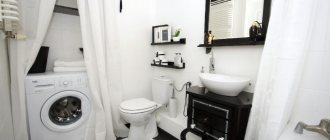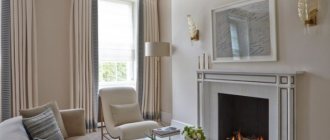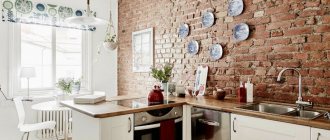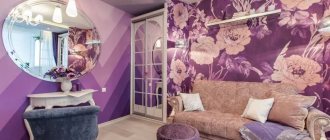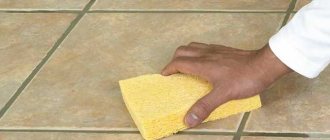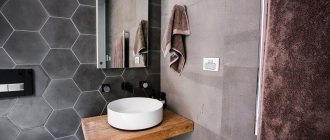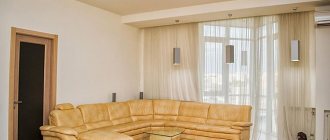Nowadays, there are such a huge number of materials for wall decoration that choosing one can be very difficult. One of the most popular options is tiles for interior wall decoration. Tile materials are also varied and are selected depending on the purpose of use.
For example, in some rooms the walls are decorated with gypsum tiles. But especially popular are bathroom wall tiles made from clay and some admixtures called ceramics.
In order to obtain an ideal wall covering that will last for many years, it is necessary to select the right types of material.
The photo of wall decoration with tiles reflects numerous types of design of modern ceramic tiles. But photographs alone are not enough to find the right design.
Next, we will describe in more detail the pros and cons of tiles, and also determine what selection rules exist.
Where can tiles be used?
All finishing work can be divided into:
- Internal;
- External.
Based on where the repairs are planned, the appropriate type of building material is selected.
Manufacturers offer a huge range of products, each with its own advantages or disadvantages, so when going to the store, it is better to be “savvy” on the topic.
Decorating walls with tiles is a relatively new type of decorating residential premises, but it is gaining momentum due to its practicality and durability.
Mosaic
There are three ways to make mosaic panels:
- Classical or “Roman mosaic”. This is an original work in which the master creates an artistic composition from small elements of different sizes and colors. And the smaller the element, the more accurate the detailing of the drawing.
Robotic mosaic made to order. The mosaic panel is made at the factory using robotic systems based on a picture or photograph of the client. The complex consists of three units: a hopper with checks (matrices), an orientator and a robot for setting a pattern on a sticky base. - Finished mosaic from the catalog. The catalog image is divided into sections of standard sizes. All receipts of each matrix on the front side of the image are sealed with paper. At the site, the master assembles panels from individual matrices, gluing each fragment in its place onto a prepared base. Then he moistens the paper, removes it from the front layer, and seals the seams.
Glass mosaic coffee Mix - Mosaics can be made from different materials: stone or ceramic tiles, metal chips (polished or with an engraved design), glass or smalt. There are also types of glass mosaics interspersed with semi-precious stones, foil petals or threads of precious metals.
Instructions for laying decorative brick-like tiles on the wall:
Subscribe
Variety of cladding materials
The construction market industry is rich in choice, and sometimes makes you rack your brain over what type of finishing to choose.
But once you start a renovation, there is no turning back, and you have to choose from what is available. And to put it mildly, there are plenty of options:
- Lining;
- Drywall;
- Decorative panel;
- Decorative plaster;
- Plastic panels;
- Ceramic tiles
- Plywood.
And these are just the most common types of building materials for decorating surfaces. The leader among the listed options is tiles for interior wall decoration.
Spectacular accent wall decoration
An accent wall is a popular technique in decorating a bedroom or living room. Unusual ceramic tiles or porcelain stoneware are perfect for its implementation.
For an accent wall, you should choose bright colors or original textures. Suitable options: relief 3D ceramics, tiles stylized as metal, plaster or fabric, large-format porcelain tiles with a pattern of valuable finishing stone, ceramic panels.
Photo: Vallelunga Memento relief tiles on an accent wall in the living room.
In the photo: an accent wall in the bedroom, lined with Apavisa Cast Iron porcelain tiles.
In the photo: an accent wall covered with Atlas Concorde Arty porcelain stoneware.
In the photo: Impronta Beige Experience porcelain tiles.
In the photo: decor from the Atlas Concorde AXI collection is perfect for an accent wall in a living space.
Photo: kitchen accent wall finished with Del Conca Portland tiles.
The trend for 2022 is small-format tiles with unusual shapes.
In the photo: an accent wall finished with textured black Equipe Rhombus tiles.
Gypsum tiles and its features
Often the material is used to decorate the interior of the room. Finishing walls with gypsum tiles has a huge number of advantages, and the reason for this is the following properties:
- Affordable cost;
- Wide range of choice;
- Excellent noise insulation properties;
- Suitable for rooms with high humidity;
- Low load due to low weight;
- Made from natural ingredients;
- Durability;
- The materials are of the same thickness, which means you don’t have to select elements when laying them.
It would seem that there are many positive aspects, but there are also weaknesses here.
We recommend reading:
Original painting of walls in an apartment - cheap and beautiful: photo examples of painting wallsTurquoise walls - design ideas, stylish combinations and design features (130 photos)
Photo frames on the wall - placement ideas and options for decorating walls using photo frames (115 photos and videos)
How to lay the first row
A base with an area of 1 square meter is covered with glue. A spatula is used. But additional application is required on the back side of the tile.
- Installation starts from the bottom right corner. We are gradually moving towards the top.
- To do this, we focus on a single horizon, thanks to the building level.
- To fix the result, a rod or cord is used. Almost standard tile laying is carried out.
Disadvantages of gypsum products
On the Internet you can find photos of wall decoration with tiles, but only when you start renovation work does it become clear that not everything is as simple as it seems at first glance.
To avoid mistakes, it is worth considering such disadvantages as:
- Highly susceptible to mechanical damage;
- Difficult to maintain (accumulates dust);
- It is necessary to treat with special solutions that prevent moisture absorption.
When compared with other building materials, this has a minimal number of shortcomings, and with proper organization of care, it will not cause trouble for the owners.
Preliminary preparation
Depending on the specific surface, its preliminary preparation may be different. However, in any case, it is necessary to achieve a high-quality result. This stage includes the selection of materials and suitable tools, as well as preparatory processing of the walls.
Tools
You need to collect the following tools in advance:
- hacksaw for metal
- grinder for stone;
- building level, square, tape measure and cord;
- spatulas (notched and regular);
- brushes, roller;
- rubber hammer.
This list may vary depending on the nuances of the work to be done and considerations of personal convenience.
Surface preparation
Here the volume and complexity of preparation depends on the characteristics of the surface. Walls without any finishing are ideal. It is enough just to thoroughly clean them from dust and dirt, and then cover them with primer several times.
Surfaces already coated in any way will have to be pre-cleaned of the old finish.
Dismantling the coating
Various dismantling methods are possible. Their choice is dictated by the characteristics of the materials used in the old coating.
- Latex paint. After cleaning the wall from dust, this coating should be moistened generously with water and wait a while. After this, the paint can be scraped off with a spatula. Usually it sticks securely to the walls, so removing it is not always advisable.
- Oil-based paint is processed with sandpaper. Existing cracks, peeling and other defects are carefully cleaned and covered with putty.
- Chalk whitewash is easily washed off with water.
- Paintwork can also be sanded, sanded and wiped well.
- Tile. You can get rid of it using a spatula or knife, after thoroughly wetting the grout with water. If the work has to be carried out in several stages, it is recommended to wet the seams each time. This method is justified if fairly soft grout was used. Otherwise, a grinder will be useful for working with stone, with which you need to clean the seams.
Alignment of walls
Having gotten rid of the remnants of the old coating, the walls need to be leveled. All cracks and surface irregularities are filled with gypsum plaster with mandatory reinforcement.
After the putty has dried, it must be rubbed well, finally leveling the surface.
Padding
Mandatory priming of the walls will help increase the effectiveness of the adhesive composition. High-quality primed surfaces will improve adhesion.
It would be a good idea to coat the back side of the tile with a special primer (an acrylic-based composition is suitable here).
Even when working on wood or plasterboard surfaces, a primer is necessary.
Some tips for use
It is not always necessary to use plaster to level the surface. And in terms of time, this process will be long and painstaking.
Not to mention the fact that in this case you will need additional specialized tools and a huge amount of construction waste.
Glue or cement must be diluted in certain proportions. Details of preparing the solution are written on the packaging. It is extremely important to strictly follow the instructions, as this will directly affect the service life.
When using various options for finishing walls with tiles, it is worth preparing all the necessary tools and consumables in advance.
Drawing in two planes
Porcelain stoneware allows you to implement a solution that is inaccessible to other materials - the transition of the pattern from the surface of the walls to the floor. To create decor in two planes, you can choose a frieze panel or create a contrasting pattern yourself from plain elements.
To implement this technique, it is best to choose universal porcelain tiles. Remember that floor tiles are suitable for wall cladding, but wall tiles for floors are not.
In the photo: Goldencer Concrex ceramic tiles.
In the photo: a geometric pattern made from small plain tiles Equipe Rhombus.
In the photo: wall decor turning into floor decor. Realonda Florencia collection.
Ideas for creating panels
When the question arises of what the design of a room for water procedures should be like so that it is both pleasant to be in and to have fun, then it is effective and budgetary to purchase a tile panel for the bathroom from Leroy Merlin.
Then the beginning and end of the day will create exactly the mood that will have a positive effect on your future pastime.
Buyers have a complete online catalog at their disposal, thanks to which there is a great opportunity to get some inspiration for their own creative ideas and practical directions for their implementation.
The selection of products is compiled in such a way that buying a tile panel for finishing a bathroom will not require much time and labor. Price variations will always pleasantly surprise and delight.
Types of decor
For proper styling of plumbing rooms, you can use a variety of wall decor. It allows you to highlight niches, stylize and separate surfaces. Original additions are of the following types:
- Mosaic;
Small tiles help highlight parts of the walls. They can be used for pasting the screen, laying out the lower half of the walls, separating them (laid out in a thin or wide strip). Suitable for decorating the space above baseboards, filling niches, and highlighting shower areas.
- Border;
Used for horizontal and vertical division of space. Represents small rectangles.
- Panel;
They can have medium and large sizes. They represent a finished image (applying a picture to one element) or are used for laying out large paintings by composing elements with different parts of the picture.
- Piece elements.
They are similar to border elements, but have a greater height and width. They are used to separate walls, complemented by patterns and abstractions.



